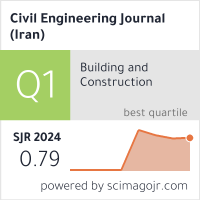Cluster-Driven Predictive Model for Asphalt Pavement Maximum Temperature in Tropical Airport
Downloads
Doi:10.28991/CEJ-2025-011-03-01
Full Text:PDF
Downloads
[2] Sulejmani, P., Said, S., Agardh, S., & Ahmed, A. (2021). Impact of temperature and moisture on the tensile strain of asphalt concrete layers. International Journal of Pavement Engineering, 22(13), 1711–1719. doi:10.1080/10298436.2020.1715404.
[3] Ebrahim Abu El-Maaty, A. (2017). Temperature Change Implications for Flexible Pavement Performance and Life. International Journal of Transportation Engineering and Technology, 3(1), 11. doi:10.11648/j.ijtet.20170301.11.
[4] Losa, M., Bacci, R., & Leandri, P. (2008). A statistical model for prediction of critical strains in pavements from deflection measurements. Road Materials and Pavement Design, 9(Sup 1), 373–396. doi:10.1080/14680629.2008.9690175.
[5] Lukanen, E. O., Stubstad, R., Briggs, R. C., & Intertec, B. (2000). Temperature predictions and adjustment factors for asphalt pavement (No. FHWA-RD-98-085; DBNX94822-D; NTIS-PB2000107444). Turner-Fairbank Highway Research Center, McLean, United States.
[6] Marshall, C., Meier, R., & Welch, M. (2001). Seasonal temperature effects on flexible pavements in Tennessee. Transportation Research Record, 1764, 89–96. doi:10.3141/1764-10.
[7] Wibowo, A., Subagio, B. S., Rahman, H., & Frazila, and R. B. (2024). Evaluation of the Airport Pavement Condition Index in the Aircraft Lateral Wander Area. International Journal of GEOMATE, 27(122), 87–95. doi:10.21660/2024.122.g13151.
[8] Ntramah, S., Tutu, K. A., Tuffour, Y. A., Adams, C. A., & Adanu, E. K. (2023). Evaluation of Selected Empirical Models for Asphalt Pavement Temperature Prediction in a Tropical Climate: The Case of Ghana. Sustainability, 15(22), 15846. doi:10.3390/su152215846.
[9] Direktorat Jenderal Bina Marga. (2024). Road Pavement Design Manual. No. 03/M/BM/2024. Direktorat Jenderal Bina Marga, Jakarta, Indonesia. (In Indonesian).
[10] Akbulut, H., Atilgan Gevrek, L., & Ay, M. (2024). Modeling of Asphalt Pavement Surface Temperature for Prevention of Icing on the Surface. Turkish Journal of Civil Engineering, 35(2), 1–21. doi:10.18400/tjce.1211542.
[11] Herry, P., Subagio, B. S., Hariyadi, E. S., & Wibowo, S. S. (2024). Integrating Regional Pavement Temperature into Simplified Material Characterization for Airport Pavement Rating. International Journal of GEOMATE, 27(120), 85–95. doi:10.21660/2024.120.g13162.
[12] Sun, L. (2016). Structural Behavior of Asphalt Pavements. Butterworth-Heinemann, Oxford, United Kingdom. doi:10.1016/C2014-0-02643-3.
[13] Adwan, I., Milad, A., Memon, Z. A., Widyatmoko, I., Ahmat Zanuri, N., Memon, N. A., & Yusoff, N. I. M. (2021). Asphalt Pavement Temperature Prediction Models: A Review. Applied Sciences, 11(9), 3794. doi:10.3390/app11093794.
[14] Zhang, J., Fwa, T. F., Tan, K. H., & Shi, X. P. (2003). Model for nonlinear thermal effect on pavement warping stresses. Journal of Transportation Engineering, 129(6), 695–702. doi:10.1061/(ASCE)0733-947X(2003)129:6(695).
[15] Asefzadeh, A., Hashemian, L., & Bayat, A. (2017). Development of statistical temperature prediction models for a test road in Edmonton, Alberta, Canada. International Journal of Pavement Research and Technology, 10(5), 369–382. doi:10.1016/j.ijprt.2017.05.004.
[16] Alavi, M. Z., Pouranian, M. R., & Hajj, E. Y. (2014). Prediction of asphalt pavement temperature profile with finite control volume method. Transportation Research Record, 2456(1), 96–106. doi:10.3141/2456-10.
[17] Ayasrah, U. B., Tashman, L., AlOmari, A., & Asi, I. (2023). Development of a temperature prediction model for flexible pavement structures. Case Studies in Construction Materials, 18, e01697. doi:10.1016/j.cscm.2022.e01697.
[18] Huang, Y., Nojumi, M. M., Ansari, S., Hashemian, L., & Bayat, A. (2024). Multi-depth temperature prediction using machine learning for pavement sections. Journal of Applied Remote Sensing, 18(01), 4517. doi:10.1117/1.jrs.18.014517.
[19] Kebede, Y. B., Yang, M. Der, & Huang, C. W. (2024). Real-time pavement temperature prediction through ensemble machine learning. Engineering Applications of Artificial Intelligence, 135, 1–21. doi:10.1016/j.engappai.2024.108870.
[20] Diefenderfer, B. K., Al-Qadi, I. L., & Diefenderfer, S. D. (2006). Model to predict pavement temperature profile: Development and validation. Journal of Transportation Engineering, 132(2), 162–167. doi:10.1061/(ASCE)0733-947X(2006)132:2(162).
[21] Chao, J., & Jinxi, Z. (2018). Prediction Model for Asphalt Pavement Temperature in High-Temperature Season in Beijing. Advances in Civil Engineering, 2018, 1–11. doi:10.1155/2018/1837952.
[22] Hassan, H. F., Al-Nuaimi, A., Al-Oraimi, S., & Jafar, T. M. A. (2008). Development of asphalt binder performance grades for Omani climate. Construction and Building Materials, 22(8), 1684–1690. doi:10.1016/j.conbuildmat.2007.06.016.
[23] Zeiada, W., Ashour, A. G., Mirou, S. M., Abuzwidah, M., & Shanablah, A. (2024). Development of superpave asphalt binder specifications to meet climate conditions in the UAE. International Journal of Pavement Engineering, 25(1), 2386627. doi:10.1080/10298436.2024.2386627.
[24] Wahhab, H. I. A.-A., Asi, I. M., & Ramadhan, R. H. (2001). Modeling Resilient Modulus and Temperature Correction for Saudi Roads. Journal of Materials in Civil Engineering, 13(4), 298–305. doi:10.1061/(asce)0899-1561(2001)13:4(298).
[25] Tabatabaie, S. A., Ziari, H., & Khalili, M. (2008). Modeling Temperature and Resilient Modulus of Asphalt Pavements for Tropic Zones of Iran. Asian Journal of Scientific Research, 1(6), 579–588. doi:10.3923/ajsr.2008.579.588.
[26] Salem, H. A. (2015). Research of the relevant temperatures for the design of pavement constructions on the desert roads in Libya. Ph.D. Thesis, University of Novi Sad, Novi Sad, Serbia.
[27] Nivitha, M. R., & Krishnan, J. M. (2014). Development of Pavement Temperature Contours for India. Journal of the Institution of Engineers (India): Series A, 95(2), 83–90. doi:10.1007/s40030-014-0074-y.
[28] Ariawan, I. M. A., Subagio, B. S., & Setiadji, B. H. (2015). Development of asphalt pavement temperature model for tropical climate conditions in West Bali region. Procedia Engineering, 125, 474–480. doi:10.1016/j.proeng.2015.11.126.
[29] Ntramah, S., Tutu, K. A., & Tuffour, Y. A. (2024). Development of Asphalt Pavement Temperature Prediction Models for Sub-Saharan Tropical Climate: The Case of Ghana. International Journal of Pavement Research and Technology. doi:10.1007/s42947-024-00451-x.
[30] Herry, P., Subagio, B. S., Susanto, E. H., & Wibowo, S. S. (2024). Development of Maximum Temperature Prediction Model within Asphalt Pavement Layers for Airports in Tropical Regions. 18th East Asia-Pacific Conference on Structural Engineering and Construction (EASEC-18), 13-15 November, 2024, Chiang Mai, Thailand.
[31] Shrivastav, A. (2021). Research Paper for Smart Home Automation System using ESP32 with Blynk, IR Remote & Manual control Relay, IoT Project. International Journal of Innovative Research in Electrical, Electronics, Instrumentation and Control Engineering, 9(5), 368–372.
[32] M. Broell, L., Hanshans, C., & Kimmerle, D. (2023). IoT on an ESP32: Optimization Methods Regarding Battery Life and Write Speed to an SD-Card. Edge Computing - Technology, Management and Integration. IntechOpen, London, United Kingdom. doi:10.5772/intechopen.110752.
[33] Christopher, J. O., Resquites, M., Parrocho, M. A., Vinegas, N., Vinyl, D. R., & Oquiño, H. (2023). IoT-Based Temperature Monitoring and Automatic Fan Control Using ESP32. IRE Journals, 7(5), 35–44.
[34] Kengkla, N., Ratanaphan, S., Earmyang, T., Chokdurong, M., & Tisa, P. (2020). The rejuvenation of valve-regulated lead-acid (VRLA) battery with pulse width modulation (PWM) charging and ultrasonic (No. 2775). EasyChair, Wythenshawe, United Kingdom.
[35] Tang, J.-X., Du, J.-H., Lin, Y., & Jia, Q.-S. (2020). Predictive Maintenance of VRLA Batteries in UPS towards Reliable Data Centers. IFAC-PapersOnLine, 53(2), 13607–13612. doi:10.1016/j.ifacol.2020.12.854.
[36] de Anda, M. F., Butler, P. C., Miller, J. L., & Moseley, P. T. (2004). Reliability of valve-regulated lead-acid batteries for stationary applications (No. SAND2004-0914). Sandia National Laboratories (SNL), Albuquerque, United States.
[37] Kong, H., Wang, J., Cai, L., Cao, J., Zhou, M., & Fan, Y. (2024). Surface Solar Radiation Resource Evaluation of Xizang Region Based on Station Observation and High-Resolution Satellite Dataset. Remote Sensing, 16(8), 1405. doi:10.3390/rs16081405.
[38] Huang, Y. H. (2004) Pavement Analysis and Design (2nd Edition). Pearson Prentice Hall, Upper Saddle River, United States.
[39] RDO Asphalt 09/24. (2009). Guidelines for the calculation of the superstructure of traffic areas with asphalt surface layer. FGSV Verlag, Köln, Germany. (In German).
[40] KleizienÄ—, R., Vaitkus, A., Š½idanaviÄiŠ«tÄ—, J., & MarcinkeviÄius, E. (2017). Classification of surface temperature for the flexible pavement design. Proccedings of 10th International Conference "Environmental Engineering.” doi:10.3846/enviro.2017.139.
[41] Lasdon, L. S., Fox, R. L., & Ratner, M. W. (1974). Nonlinear optimization using the generalized reduced gradient method. Revue Française d'automatique, Informatique, Recherche Opérationnelle. Recherche Opérationnelle, 8(V3), 73–103. doi:10.1051/ro/197408v300731.
- Authors retain all copyrights. It is noticeable that authors will not be forced to sign any copyright transfer agreements.
- This work (including HTML and PDF Files) is licensed under a Creative Commons Attribution 4.0 International License.![]()















